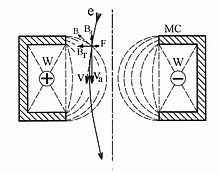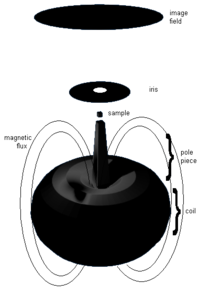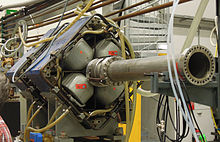- Magnetic lens
-
A magnetic lens is a device for the focusing[disambiguation needed
 ] or deflection of charged particles, such as electrons or ions. Charged particles are deflected based upon the strength of the magnetic field, which can be varied by controlling the current flowing through several electromagnets. These typically find diverse applications, from cathode ray tubes to electron microscopy.
] or deflection of charged particles, such as electrons or ions. Charged particles are deflected based upon the strength of the magnetic field, which can be varied by controlling the current flowing through several electromagnets. These typically find diverse applications, from cathode ray tubes to electron microscopy.A magnetic lens typically consists of several electromagnets arranged in a quadrupole (or quadrapole) or sextupole format. This consists of several electromagnetic coils placed at the vertices of a square or hexagon respectively. From this configuration a convex magnetic field can be formed, which has the effect of focusing (or diverging) charged particles.
The passing electron is subjected to two vector forces, one parallel to the core (HZ), and one parallel to the radius of the lens (HR). The force parallel to the core causes the electron to spiral through the lens, and this spiraling expose the electron to HR which in turn focus the electron. Note that the magnetic field is inhomogeneous, electrons close to the center are less strongly deflected than those passing the lens far from the axis.[1]
Sources
- R. F. Egerton; Electron energy-loss spectroscopy in the electron microscope; Springer, 1996.
- John M. Rodenburg, Institute of Physics (Great Britain). Electron Microscopy and Analysis Group; Electron microscopy and analysis 1997: proceedings of the Institute of Physics Electron Microscopy and Analysis Group Conference, Cavendish Laboratory, University of Cambridge, 2-5 September 1997; Institute of Physics Pub., 1997.
References
See also
Categories:- Types of magnets
- Optics
- Electromagnetism stubs
Wikimedia Foundation. 2010.



